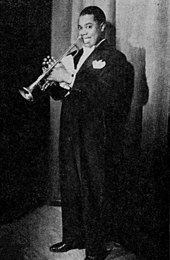


Black and Tan clubs were nightclubs in the United States in the early 20th century catering to the black and mixed-race ("tan") population.[1][2] They flourished in the speakeasy era and were often popular places of entertainment linked to the early jazz years. With time the definition simply came to mean black and white clientele.
The black populations of the large Northern cities in which these clubs arose (e.g. Cincinnati, Manhattan, San Francisco, Seattle) consisted of immigrants, recently arrived from rural areas (especially, from the South[3]). In this context of rural-urban and North-South migration, the Black and Tan clubs provided a cultural haven and "refuge for new ethnic immigrants to continue practicing their cultural traditions".[4] Though often owned by whites, the Clubs also offered a springboard to success for black musicians. They provided opportunities for local talent and hosted nationally acclaimed jazz musicians, sometimes launching their careers (e.g. Ethel Waters, Jelly Roll Morton,[5] Louis Armstrong and Cab Calloway[6]).
Although originally conceived as a venue for blacks, the liberal attitudes of the clubs often attracted both whites and black and offered a place for "social exchange between races that were discouraged in other public spaces."[4] Indeed, many "white musicians came to the black sections of towns to listen to black jazz and learn from black musicians".[7] The Clubs attracted artists and Bohemians of both races.
Nevertheless, this was a highly imperfect inter-mixing of white and black America. Some of the clubs catered to an almost exclusively white clientele, with blacks intervening only as performers and servers (e.g. the Cotton Club and the Plantation Club in Harlem). Furthermore, white customers at the clubs may have been seen by black customers as 'slumming'[4] intruders, but, for owners, whites were generally welcomed as a paying clientele.
The clubs were viewed as socially and sexually disreputable by both blacks and whites in the wider society of the time.[8][7] Informed by the sensationalist coverage in the printed press, whites feared that the clubs encouraged crime, racial impurity and moral corruption. This fear is exemplified in a 1914 letter written by a leading citizen of New York (the General Secretary of the Committee of Fourteen) who laments that the Black and Tan clubs were "catering not only to whites, as well as blacks, stimulating a mixing of the races."[4] Indeed, some clubs dealt with this mutual fear and distrust by physically separating blacks and whites within the venue while other clubs provided separate hours for white and black clientele.[7]
The clubs were also the first "gay friendly" establishments.
- ^ "The Devil's Music: 1920's Jazz (final film in the 4-part Culture Shock series)". WGBH. Retrieved 2023-01-16.
- ^ Hill, Megan (2017-09-19). "Much-Anticipated Black and Tan Hall Should Open Any Minute Now". Eater Seattle. Retrieved 2023-01-16.
- ^ "Jazz Arrives in Northeast Ohio (U.S. National Park Service)". www.nps.gov. Retrieved 2025-01-27.
- ^ a b c d "Slumming and Black-and-tan Saloons: Racial Intermingling and the Challenging of Color Lines". Researching Greenwich Village History. 2011-11-03. Retrieved 2025-01-26.
- ^ Kamiya, Gary (2013-10-26). "Barbary Coast joint hosted jazz pioneer". SFGATE. Retrieved 2023-01-16.
- ^ Barberella (2010-11-30). "PlanetBarberella's Bipolar express: Earl "Fatha" Hines.....Chicago...Grand Terrace Cafe NBC remote 1938". PlanetBarberella's Bipolar express. Retrieved 2025-01-26.
- ^ a b c "B is for Black-and-Tan (AtoZ Challenge - Roaring Twenties)". 2 April 2015.
- ^ "Civil Rights in Black and Tan". 27 January 2005.
